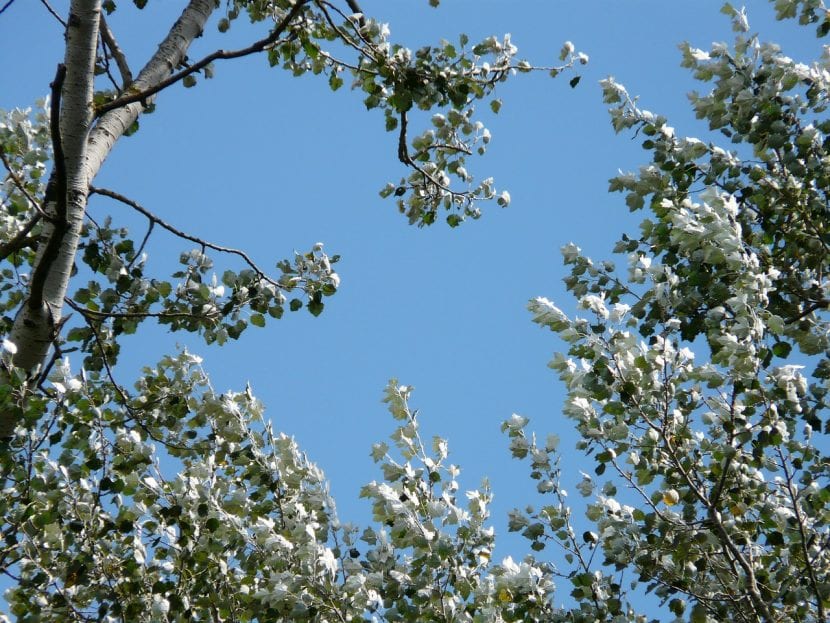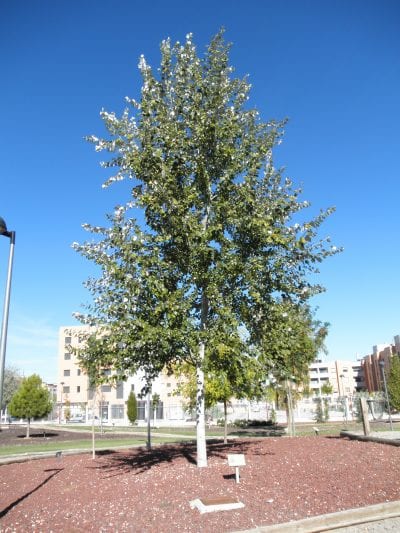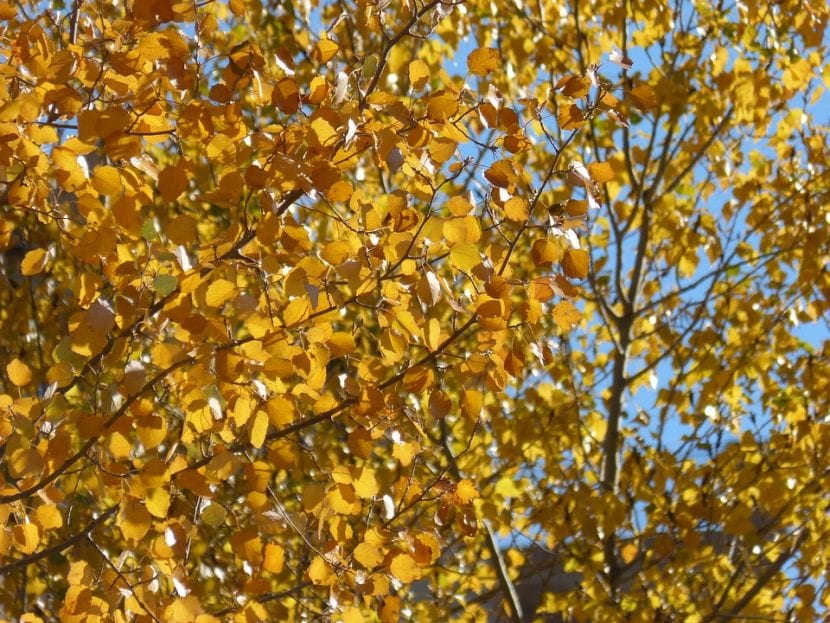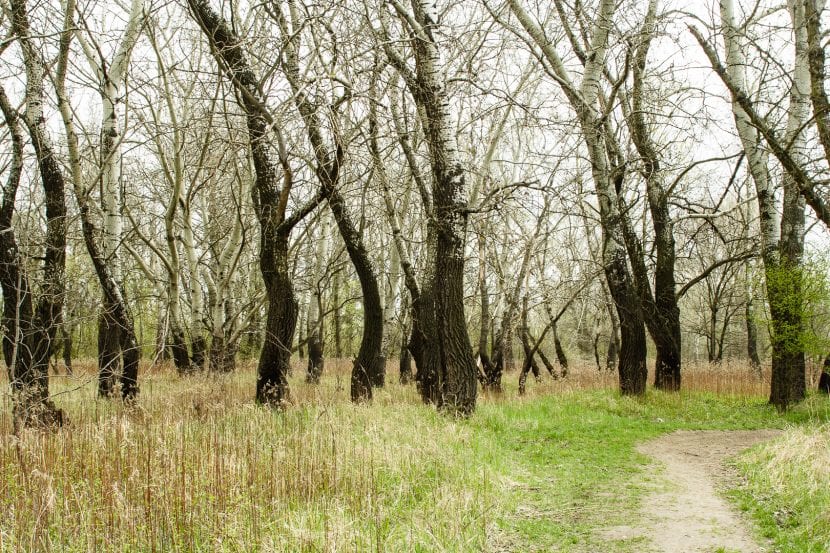
If you need to add color to your garden and want to take advantage of it to create a tall hedge or have several isolated white spots, this tree is sure to delight you: it is fast growing and requires little maintenance. Your name? White poplar.
The leaves are pure white on the underside, which makes it a species very decorative. Read on to know everything about it: its cultivation, its care, its uses, ... everything.
Characteristics of white poplar

Our protagonist is a deciduous tree whose scientific name is the white and which is known as white poplar, silver poplar, or white poplar that loses its leaves in autumn-winter. It is native to Europe, Asia and North Africa. In Spain it can be found especially in the mountains of the Iberian Peninsula; In the Balearic and Canary archipelagos, the temperature and soil conditions do not allow it to grow normally.
It reaches a height of 30 meters and a diameter of up to 1m. It is columnar in shape, with a thick trunk. Its root system is very strong, so It should not be planted at a distance of less than ten meters from pipes or any other type of construction as it could easily break them.
The leaves are simple, alternate, oval or palmate in shape and the edge is serrated, covered on the underside with a layer of whitish hairs. The upper surface is dark green, except in autumn when it turns yellowish..
If we talk about its flowers, it must be said that it is a dioecious species, which means that there are male and female specimens. The flowers of the former appear in hanging catkins and are large red; On the other hand, those of the latter are yellow-greenish in color. White poplars bloom in the spring, before the leaves sprout.
The fruit is a bivalve capsule, ovoid in shape inside which are the seeds that have hairs to be able to be displaced by the wind.
How do you take care of yourself?

Do you want to have a specimen in your garden? Follow our tips so you can enjoy your tree:
Location
Being a large plant, it has to be planted in medium or large gardens, at a minimum distance of 10m from pipes or any other type of construction, and about 3m from any other plant.
It is important that it is in direct sunlight so that it can develop well.
Land
It is not demanding. It can grow both on the sandy coastal areas near the beach and on the calcareous ones if you have enough water. Of course, you have to know that it develops better in those that are fresh and rich in organic matter.
Irrigation
You need frequent waterings. In fact, if you live near a stream or river, you can plant it nearby; otherwise, don't worry. It will be enough to water it three to four times a week during the hottest months and somewhat less the rest of the year.
Subscriber

White poplars in autumn.
Although white poplar is very hardy, it does not hurt to pay it from time to time with organic fertilizersas horse manure or goat. You will appreciate two or three contributions per year.
Pruning
Towards the end of winterWhen the temperature begins to rise, it can be pruned, thus eliminating dry, weak and / or diseased branches.
Multiplication
This plant reproduces by seeds, by cuttings and by shoots. Let's see how to proceed in each case:
Seeds
- The first thing to do is, in autumn, fill a plastic tupperware with vermiculite and moisten it with water.
- Then the seeds are sown and covered with more vermiculite.
- Then tupperware is placed in the fridge for three months, opening it only once a week so that the air is renewed.
- After that time, the seeds are sown in a pot with universal culture substrate mixed with 30% perlite.
- Placed in the sun, finally it is given a good watering.
They will germinate in a maximum of two months.
Cuttings
- At the end of winter it is due bevel cut a woody branch that looks healthy and measures about 40cm long
- Later moistens the base of the cutting with water and is infused with rooting hormones powdered.
- Then it plant in a pot with universal growing substrate.
- Finally, is watered and placed in a protected area direct sun.
If all goes well, it will root after 1-2 months.
New shoots
Adult trees have a great tendency to shoot shoots at the base of their trunks. To separate them, three ditches about 30cm deep have to be made around the small poplars and, with a hand shovel, make a little lever.
Once they are out, are planted in pots in semi-shade until growth is seen, something that will happen after two or three weeks.
Plagues and diseases
You can be affected by the following:
- White fly: it is a small white flying insect that attaches itself to the underside of the leaves to feed on the sap. Thus, the plant turns yellow and, in very serious cases, it can become peeled. To avoid this, it is highly recommended to plant aromatic plants nearby, since the smell repels them.
- Saperda or poplar borer: It is a coleopteran insect similar to the grasshopper that makes galleries in the trunk of the tree. They are eliminated with anti-piercing insecticides.
- Powdery mildew: It is a fungus that covers the leaves with a coating similar to that of ash, which is why it is known as gray mold disease. It can be treated with a systemic fungicide.
Rusticity
White poplar withstands temperatures of up to -17ºC, and high temperatures (30-35ºC) as long as you have a constant water supply.
What is?

This is a tree that has many uses. It is grown as an ornamental plant, either as an isolated specimen or as a windbreak hedge; also in carpentry to make packaging, plywood, cellulose pulp or panels; and in natural medicine as its cooked leaves and bark help heal wounds.
It is therefore a very interesting species that you can have in your garden and enjoy its wonderful shade. If you like the idea, you will surely find the perfect specimen in a nearby nursery 😉.
It does not seem like a good option to me, that tree is destroying the parks and gardens where I live, in the areas where there are poplars, little trees are sprouting everywhere and they are spoiling the green areas, I also do not like the white color it has the underside of the leaves and I don't like its scientific name either
Hello, I have 5 white poplars in a row, they are large and healthy, and they are located to the south to shade my house. I am thinking of putting photovoltaic panels on the roof but their performance would be reduced by the shade of the poplars.
It does not cross my mind to remove them, could you advise me how to reduce the effect with some type of pruning or something else?
Thank you
Hello Antonio.
How big are they? It is that they can be pruned, but so that this pruning does not do them much damage, it should be done little by little. That is to say, it is not good that if a tree measures we are going to say 3 meters, one meter is removed at one time, because it is most likely that we would lose it. But if that same tree is removed 30 centimeters, and it is allowed to remove lower branches (in a year they usually do), then there would be no problem.
If you want write us to gardening-on@googlegroups.com sending a photo of the trees and we will help you.
Greetings.
Greetings ... would it be feasible to plant a white poplar in a hole of 75x75x75 cm and whose sides (but not the bottom) have a layer of cement so that it does not extend its roots so close to the surface?
Hello Martin.
Yeah right. But keep in mind that it couldn't reach its maximum height 🙂
Greetings.